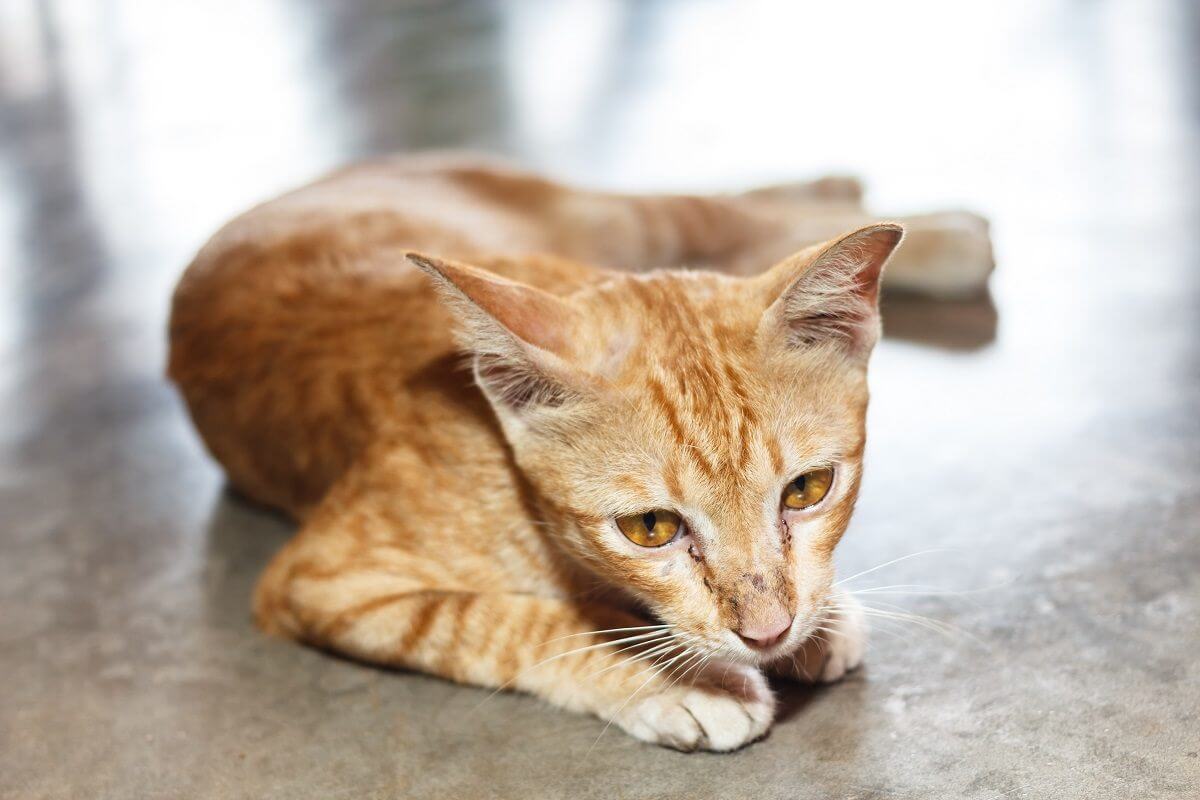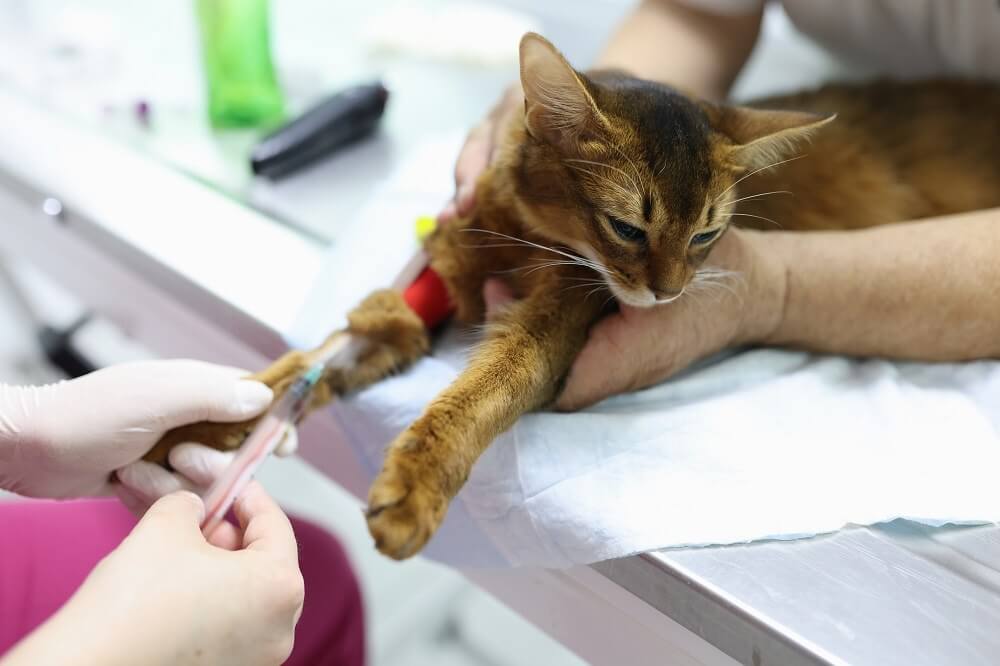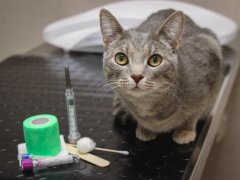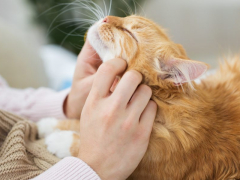
21MARCH/ Shutterstock.com
Addison’s disease is a rare condition in cats caused by disease or damage to the adrenal glands. This condition is technically known as “hypoadrenocorticism,” which means there is reduced activity of the adrenal cortex, the hormone-producing outer section of the adrenal glands.
Quick Overview: Addison’s Disease in Cats
 Other Names: Hypoadrenocorticism, Addisonian crisis
Other Names: Hypoadrenocorticism, Addisonian crisis
 Common Symptoms: Dullness, weakness, inappetance, vomiting, diarrhea and weight loss
Common Symptoms: Dullness, weakness, inappetance, vomiting, diarrhea and weight loss
 Requires Ongoing Medication: Yes
Requires Ongoing Medication: Yes
 Vaccine Available: No
Vaccine Available: No
 Treatment Options: Daily oral medication with replacement adrenal hormones (steroids)
Treatment Options: Daily oral medication with replacement adrenal hormones (steroids)
 Home Remedies: Regular monitoring by your vet, including physical examinations and blood tests
Home Remedies: Regular monitoring by your vet, including physical examinations and blood tests
The signs tend to wax and wane—for example, cats may show some symptoms of the disease, then improve spontaneously. These symptoms include a decreased appetite, lethargy, vomiting and diarrhea. Occasionally, cats go into an “Addisonian crisis,” which involves more dramatic symptoms of collapse and extreme weakness.
Let’s take a more detailed look at the causes, symptoms, and treatments of this disease.
Causes of Addison’s Disease
The signs of Addison’s disease are caused by decreased production of certain hormones normally produced by the adrenal glands, which are two small structures, one located beside each of the left and right kidneys. There are two types of Addison’s disease.
Primary Hypoadrenocorticism
Primary Addison’s disease happens when the adrenal cortex itself is damaged or diseased, resulting in reduced production of the adrenal cortex hormones. This is the most common form of Addison’s disease in cats, and the cause is usually unknown: it’s thought of as a type of auto-immune disease. Rarely does the infiltration of cancer cells (such as lymphoma) cause damage to the cortex.
Secondary Hypoadrenocorticism
Secondary Addison’s disease happens when disease elsewhere in the body has a secondary impact on the adrenal cortex, with this causing a reduction in output of adrenal cortex hormones. The most common cause of secondary Addison’s disease is conditions affecting the pituitary gland in the skull, caused by inflammation, infection, neoplasia, trauma, blood clots or hemorrhage, or idiopathic causes (i.e. no specific cause can be identified).
Symptoms of Addison’s Disease
Addison’s disease is seen more commonly in young adult cats (less than five years of age), and there is no breed of cat that’s more prone to the condition. Symptoms are caused by the low levels of the hormones that are normally produced by the adrenal cortex. The signs are often vague and intermittent at first, which can make it difficult for owners and vet to diagnose what’s going on in the early stages.
There are two broad types of hormone that become deficient: glucocorticoids and mineralocorticoids. Glucocorticoids (such as cortisol) act in a very wide number of ways in the metabolism, playing strong roles in the normal processing of nutrients, and in the way the body responds to stress. Mineralocorticoids (such as aldosterone) are involved in the control of sodium and potassium in the body.
Glucocorticoid deficiency typically results in:
- Dullness and lethargy
- Muscle weakness and generalized weakness
- Reduced appetite or anorexia
- Increased thirst
- Vomiting and diarrhea leading to dehydration, hypothermia and collapse
- Weight loss with loss of muscle mass
Mineralocorticoid deficiency typically results in:
- Bradycardia (slow heart rate) or tachycardia (fast heart rate)
- Cardiac arrhythmias (irregular heart beat)
- Weak pulses
- Weakness and dullness
In Addison’s disease, both of these hormones are deficient, resulting in a combination of these signs of disease.
Diagnosis of Addison’s Disease
If your cat has signs that may suggest Addison’s disease, your vet will take the following steps:
1. Detailed Medical History Taking
Your vet will ask about your cat’s condition and overall health care, lifestyle (such as whether they’re indoors or outdoors, their feeding routine, litter box habits, etc), and any possible exposure to toxins such as garden chemicals, toxic plants, medications, or flea treatments.
Addison’s disease is often a long term, chronic type of condition, and the vet may try to establish a timeline of your cat’s condition, going back weeks or months. For example, if your cat is vomiting, they’ll likely ask when this first began.
2. Physical Examination
Your veterinarian will then conduct a full physical exam, taking the body temperature and heart rate and listening to the heart and lungs with a stethoscope.
3. Routine Laboratory Tests
Your veterinarian may carry out some blood tests, including hematology (complete blood count) and a biochemistry profile (including liver, kidney and other parameters). Typically, high potassium levels (hyperkalemia) may be seen along with low sodium (hyponatremia), low chlorine levels (hypochloremia) and sometimes low blood sugar (hypoglycemia). Urinalysis is often carried out, and typically over-dilute urine (low specific gravity) may be noted.
Tests for common viral infections such as feline leukemia (FeLV) and feline immunodeficiency virus (FIV) may be suggested as part of a general health screen.
4. Specialized Blood Tests
Addison’s disease may be suspected from the history, physical examination, and general blood tests, but to confirm the diagnosis, a specialized blood test is needed, known as an ACTH stimulation test. First, a base cortisol level is measured, then an injection of adrenocorticotrophic hormone (ACTH) is given, and then a second cortisol level is measured.
In normal cats, the hormone injection stimulates the adrenal glands to produce cortisol, meaning the second blood cortisol level should be significantly higher than the first sample. In Addison’s disease, the cortisol level does not go up as it should do, due to the decreased activity of the adrenal cortex.

A series of blood samples are needed to confirm the diagnosis of Addison’s Disease. megaflopp / Shutterstock.com
5. Diagnostic Imaging
Radiography (x-rays) and abdominal ultrasound can rule out other causes of the symptoms. In Addison’s disease, subtle changes may or may not be seen in certain areas, but these are not likely to be specific enough to be diagnostic.
6. Electrocardiogram
If a cardiac abnormality is heard with the stethoscope (such as an arrhythmia, bradycardia or tachycardia), your vet may want to do an electrocardiogram (ECG) that can show characteristic changes.
Treatments for Addison’s Disease
If a cat is suffering from an Addisonian crisis (i.e. severe and sudden signs of illness) your vet will likely recommend intravenous fluid therapy. Glucocorticoid (steroid) supplementation is also important, however your vet may wait for a definitive diagnosis before administering this. Once the diagnostic blood tests have been carried out, glucocorticoids may then be given.
After the acute crisis has resolved, and the cat is stable, longer term maintenance treatment may be given, with supplementation of both types of hormones. Daily glucocorticoid supplementation is usually needed, along with some mineralocorticoid medication.
Your vet may choose from the following medications:
- Fludrocortisone acetate (“Florinef”) is an oral steroid with mineralocorticoid and some glucocorticoid effects.
- Desoxycorticosterone pivalate (DOCP injection, “Zycortal”, “Percorten”) is an alternative mineralocorticoid supplement which may be given by regular injection.
- Prednisone, or other glucocorticoids, may or may not be needed.

A regular injection of a mineralocorticoid is often part of the treatment for Addison’s disease. Tom Wang / Shutterstock.com
Cat Care Tips
Having a cat with a long-term illness can be stressful. Fortunately, there are some things you can do to help make your cat’s life easier.
- Monitoring: Cats with Addison’s disease need to be monitored carefully for recurrence of signs of illness, including weakness, dullness, reduced appetite, vomiting or diarrhea. Medication doses may need adjusting if your cat’s symptoms start to recur.
- Vet checks: Your cat will be re-examined regularly, as recommended by your veterinarian, to monitor their progress. Electrolytes measured in a blood sample are a key guide to the efficacy of treatment.
- Medication: Cats with Addison’s disease may be on multiple medications. Keeping a medication diary can be a useful way to keep track of doses, timings and any check ups.
Frequently Asked Questions
What does Addison’s disease look like in cats?
Addison’s disease is very rare in cats, and symptoms come and go over weeks and months, including a reduced appetite, dullness, vomiting and diarrhea. More signs, including collapse and extreme weakness, are occasionally seen if a cat suffers from an “Addisonian crisis.”
How do you treat Addison’s disease in cats?
When Addison’s disease has been diagnosed, treatment generally involves a combination of regular injections (e.g. once a month) plus daily tablets.
How much does it cost to treat Addison’s disease in cats?
Because multiple tests are needed to diagnose Addison's disease, the cost tends to be high, sometimes $2,000 or more depending on your location and the cat's specific case and condition. The ongoing cost of treatment involves both medication (e.g. $100 per month) plus monitoring tests (e.g. up to $200 per month).
What is the prognosis for cats with Addison’s disease?
Affected cats need lifelong treatment, but they are often otherwise healthy and expected to live as long as an unaffected cat.







